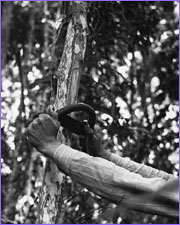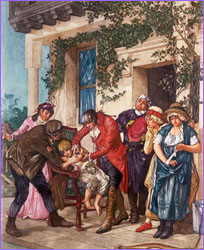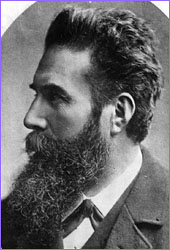 |
 |
Accidental Discoveries
by Lexi Krock
Accidents in medicine: The idea sends chills down your spine as you conjure up
thoughts of misdiagnoses, mistakenly prescribed drugs, and wrongly amputated
limbs. Yet while accidents in the examining room or on the operating table can
be regrettable, even tragic, those that occur in the laboratory can sometimes
lead to spectacular advances, life-saving treatments, and Nobel Prizes.
A seemingly insignificant finding by one researcher leads to a breakthrough
discovery by another; a physician methodically pursuing the answer to a medical
conundrum over many years suddenly has a "Eureka" moment; a scientist who
chooses to study a contaminant in his culture rather than tossing it out
stumbles upon something entirely new. Here we examine seven of medical
history's most fortuitous couplings of great minds and great luck.
|  A laborer scrapes the bark from a cinchona tree. The
bark is then sundried and pulverized to make the drug quinine.
A laborer scrapes the bark from a cinchona tree. The
bark is then sundried and pulverized to make the drug quinine.
|
Quinine
The story behind the chance discovery of the anti-malarial drug quinine may be
more legend than fact, but it is nevertheless a story worthy of note. The
account that has gained the most currency credits a South American Indian with
being the first to find a medical application for quinine. According to legend,
the man unwittingly ingested quinine while suffering a malarial fever in a
jungle high in the Andes. Needing desperately to quench his thirst, he drank
his fill from a small, bitter-tasting pool of water. Nearby stood one or more
varieties of cinchona, which grows from Colombia to Bolivia on humid slopes
above 5,000 feet. The bark of the cinchona, which the indigenous people knew as
quina-quina, was thought to be poisonous. But when this man's fever
miraculously abated, he brought news of the medicinal tree back to his tribe,
which began to use its bark to treat malaria.
Since the first officially noted use of quinine to fight malaria occurred in a
community of Jesuit missionaries in Lima, Peru in 1630, historians have
surmised that Indian tribes taught the missionaries how to extract the chemical
quinine from cinchona bark. In any case, the Jesuits' use of quinine as a
malaria medication was the first documented use of a chemical compound to
successfully treat an infectious disease. To this day, quinine-based
anti-malarials are widely used as effective treatments against the growth and
reproduction of malarial parasites in humans.
 A depiction of Edward Jenner vaccinating James
Phipps, a boy of eight, on May 14, 1796.
A depiction of Edward Jenner vaccinating James
Phipps, a boy of eight, on May 14, 1796.
|
|
Smallpox vaccination
In 1796, Edward Jenner, a British scientist and surgeon, had a brainstorm that
ultimately led to the development of the first vaccine. A young milkmaid had
told him how people who contracted cowpox, a harmless disease easily picked
up during contact with cows, never got smallpox, a deadly scourge.
With this in mind, Jenner took samples from the open cowpox sores on the hands
of a young dairymaid named Sarah Nelmes and inoculated eight-year-old James
Phipps with pus he extracted from Nelmes' sores. (Experimenting on a child
would be anathema today, but this was the 18th century.) The boy
developed a slight fever and a few lesions but remained for the most part
unscathed. A few months later, Jenner gave the boy another injection, this one
containing smallpox. James failed to develop the disease, and the idea behind
the modern vaccine was born.
Though doctors and scientists would not begin to understand the biological
basis of immunity for at least 50 years after Jenner's first inoculation, the
technique of vaccinating against smallpox using the human strain of cowpox soon
became a common and effective practice worldwide.
|  Physicist Wilhelm Conrad Röntgen (1845-1923),
discoverer of the X-ray.
Physicist Wilhelm Conrad Röntgen (1845-1923),
discoverer of the X-ray.
|
X-Rays
X-rays have become an important tool for medical diagnoses, but their discovery
in 1895 by the German physicist Wilhelm Conrad Röntgen had little to do
with medical experimentation. Röntgen was studying cathode rays, the
phosphorescent stream of electrons used today in everything from televisions to
fluorescent light bulbs. One earlier scientist had found that cathode rays can
penetrate thin pieces of metal, while another showed that these rays could
light up a fluorescent screen placed an inch or two away from a thin aluminum
"window" in the glass tube.
Röntgen wanted to determine if he could see cathode rays escaping from a
glass tube completely covered with black cardboard. While performing this
experiment, Röntgen noticed that a glow appeared in his darkened
laboratory several feet away from his cardboard-covered glass tube. At first he
thought a tear in the paper sheathing was allowing light from the high-voltage
coil inside the cathode-ray tube to escape. But he soon realized he had
happened upon something entirely different. Rays of light were passing right
through the thick paper and appearing on a fluorescent screen over a yard away.
Röntgen found that this new ray, which had many characteristics different
from the cathode ray he had been studying, could penetrate solids and even
record the image of a human skeleton on a photographic negative. In 1901, the
first year of the Nobel Prize, Röntgen won for his accidental discovery of
what he called the "X-ray," which physicians worldwide soon adopted as a
standard medical tool.
Continue: Allergy
Dr. Folkman Speaks |
Cancer Caught on Video
Designing Clinical Trials |
Accidental Discoveries |
How Cancer Grows
Help/Resources |
Transcript |
Site Map |
Cancer Warrior Home
Editor's Picks |
Previous Sites |
Join Us/E-mail |
TV/Web Schedule
About NOVA |
Teachers |
Site Map |
Shop |
Jobs |
Search |
To print
PBS Online |
NOVA Online |
WGBH
© | Updated February 2001
|
|
|